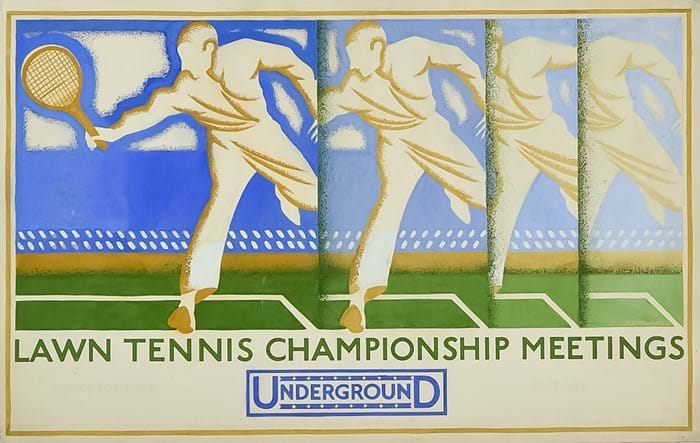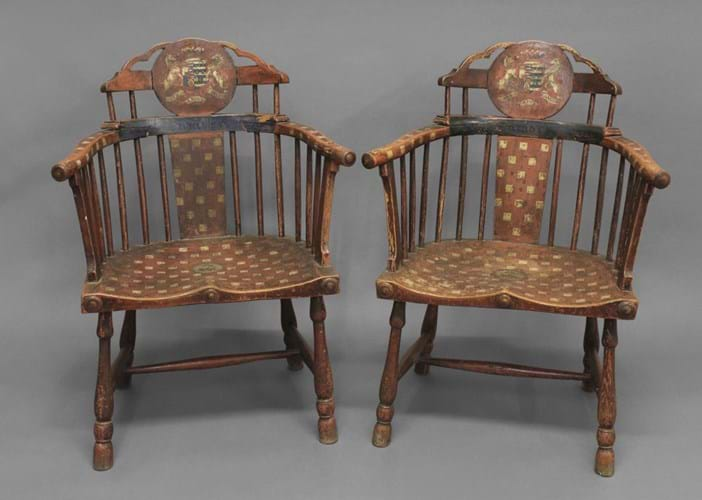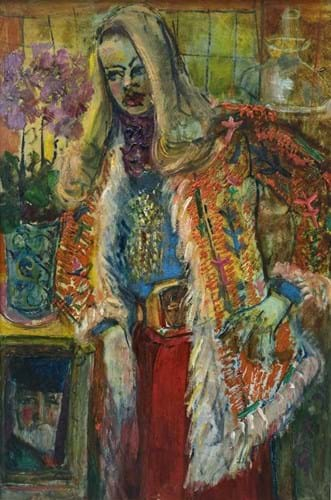1. 18th century Windsor chairs – £12,000
This pair of mid-18th century polychrome Windsor chairs are painted with the coat of arms of John Perceval, 2nd Earl of Egmont (1711-70) impaling that of his first wife, Lady Catherine Cecil (1719-52), daughter of the 5th Earl of Salisbury. They were probably made in the West Country, possibly in Bristol.
A set of similar chairs with the same red and white ground is known with the arms of the earl’s second wife, Catherine Compton, Baroness Arden of Lohort Castle. One of these is in the V&A (there was a time when it was thought to be unique) with others offered for sale in the past 20 years.
It seems they were sold together when the contents of Enmore Castle were dispersed in 1899. A group of eight chairs from the set were bought at the time by a Mrs Notley of Combe Sydenham Hall, Somerset.
This pair of chairs, offered at Lawrences of Crewkerne on April 8, were from Combe Sydenham. They had been acquired from the Notley family when the vendor’s parents bought the property.
Guided at £12,000-18,000, they took the low estimate – a decent sum for a pair of Windsor chairs but considerably less than the £19,000 bid for a single chair from the Egmont set at Brightwell's in Leominster in 2003.
2. Wimbledon tennis underground poster – £3800

Design for a London Underground poster by Albert Edward Halliwell – £3800 at Canterbury Auction Galleries.
Precious little is known about Albert Edward Halliwell (1905-1987) but his blue-chip clients in the kaleidoscopic world of inter-war commercial art included London Underground, Kellogg’s, Bryant & May, Boots the Chemist, Wimbledon and Regent’s Park Zoo.
Some of his designs became well-known travel and wartime posters. However, he later chose to apply his talents to teaching, working at the Central School of Arts and Crafts in Camden from 1948 until 1970.
The contents of Halliwell’s studio comprised hundreds of designs from the 1920s, 30s and 40s that were intended to be worked up into posters, product labels and advertisements. Mostly done in gouache with pencil annotations, they are typically much smaller in scale than the finished products and leave spaces for typographical information such as event dates, tube and bus stations.
Many elements of the collection – owned by the artist’s family – were previously used in a loan exhibition at Yorkshire Sculpture Park, near Halifax. They came for sale at the Canterbury Auction Galleries on April 11 in a sale of just over 300 lots (many of them multiples). No Artists’ Resale Right levy was applicable as this was the first times these works had ever been offered for sale.
The most eagerly contested lots were the original Art Deco designs for London Underground posters – particularly those with a sporting theme. This 11 x 18in pencil and gouache poster design created to promote the Lawn Tennis Championship Meetings at Wimbledon was estimated at £600-800 but sold at £3800 – the top price of the day.
3. Heal’s book table – £700
On April 9, Chilcotts in Honiton, Devon, offered 25 lots of Heal’s limed oak furniture from a single property. They were on the market for the first time since they were purchased new by the vendors’ grandparents at Heals’ Tottenham Court Road store in the late 1930s. The family home, bought in 1936, overlooked the sea on the south Devon coast.
There were more than 40 pieces in the sale, most of them bearing the classic Heal & Son circular ivorine plaques used in the inter-war period. Leading the consignment at £3400 (estimate £300-400) was a bedroom suite comprising a pair of single wardrobes, a dressing table and a chest of drawers. Shown here is a Heal’s limed oak circular book table, c.1930s, with two swing-out circular tiers. The 2ft 2in (66cm) wide table, opening up to 4ft 1in (1.21m), was estimated at £80-120 but sold at £700.
4. Sven Berlin portrait – £2800
Penzance saleroom David Lay sold the contents of the studio of the St Ives artist, sculptor, writer and poet Sven Berlin (1911-99) last week.
Berlin’s artistic career began in the heady days of post-war St Ives but he was on the losing side of the acrimonious battle waged between fellow figurative painters and the abstractionists. After leaving Cornwall, he wrote The Dark Monarch, a ‘roman à clef’ describing the atmosphere and squabbles in St Ives. Unfortunately for him, the characters were too recognisable and defamatory. The book was withdrawn only a few days after publication in 1962 and the resulting legal actions bankrupted Berlin.
Tucked away in a rural cottage in Dorset, and marginalised by the art world, he continued to write, paint and sculpt prolifically for the rest of his life, but never with great commercial success.
A large body of his work had been kept intact by his third wife Julia, who died last year. Consigned to the Penzance sale on April 7-8, a good number of works sold for sums between £100-300 with a handful (four sculptures and eight oils) bringing four-figure sums.
Leading the sale at £2800 was this 2ft x 3ft (60 x 90cm) oil on board titled Julia, signed and dated ‘71.
5. Battle of Waterloo letter – €2200

Letter written by Godert van der Capellen after the Battle of Waterloo – €2200 (£1900) at International Autograph Auctions.
This autograph letter was written in Brussels by Godert van der Capellen (1778-1848), the secretary of state of the Netherlands in Brussels, on June 19, 1815, at three o’clock in the morning. It was only hours after the Battle of Waterloo.
Over two pages, penned in French to his government, he quickly sketches out the events of the previous day. He mentions first that HRH the Prince of Orange had been wounded by a bullet which went through his left arm near the shoulder but then moves to news of ‘a complete and full victory of our armies’.
He added that ‘the enemy has been completely defeated and routed back’ and had lost over one hundred cannons. He finishes by saying that Marshal Prince Blucher and the Duke of Wellington were pursuing the enemy beyond Genappe.
The letter was offered for sale by International Autograph Auctions in Malaga on April 6. As an eye-witness account of a turning point in European history, it sold well above estimate at €2200 (£1900).








